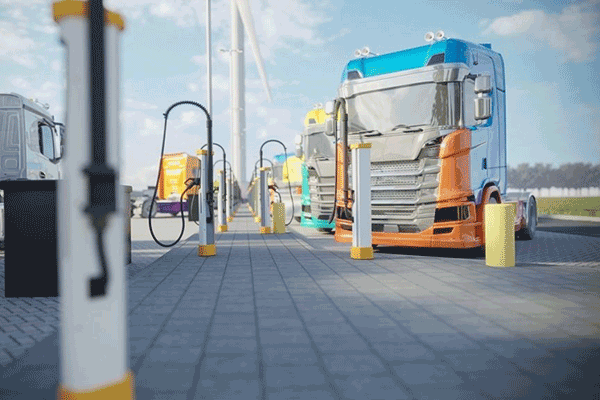As we strive for sustainable solutions in transport, electric trucks are rapidly becoming an attractive alternative to traditional diesel trucks. With over a quarter of total road transport CO2 emissions attributed to heavy-duty trucks, transitioning to an electric fleet is not only an environmentally responsible choice but also a strategic move to stay ahead in an increasingly green-conscious business world.
Electric trucks come in a variety of shapes and sizes, but in this article, we will focus on medium to heavy-duty electric trucks. These are primarily used for inner-city local trips and regional mid-haul journeys, covering a broad spectrum of transport needs.

When it comes to charging these electric giants, a DC fast charger is usually the go-to solution. The charger can be connected to the electric grid or an alternative power source. The optimal charging method varies depending on factors such as travel distance and battery size.
electric truck charging scenarios
Let’s delve into the typical charging scenarios for heavy-duty electric trucks. There are three main strategies: overnight charging, destination charging, and on-the-move charging.
Overnight charging is common, using low DC powers of 50-100 kW, taking advantage of the 6-8 hours typically available to fully charge the vehicles. Destination charging is for vehicles whose daily travel distance exceeds their range, using between 150 and 400 kW of power at logistic centers or warehouses during loading and unloading. Finally, on-the-move charging is for long-haul truck trips that cover large distances per day. These sessions use up to 1.2 MW of power during the mandatory driver breaks, recharging vehicles efficiently.
Truck electrification stages
The electrification of trucks is occurring in stages, starting with local and regional trips, then regional and mid-haul trips, and finally, long-haul trips. As we progress through these stages, the charging infrastructure is evolving alongside, with an increase in the use of destination charging and the integration of charge management in logistic processes. The third stage involves automated and fully integrated charging processes at distribution centers, powered by large-scale government subsidies and megawatt charging opportunities along highways.
The benefits of electric trucks
There are several benefits that come with electric trucks. Despite the higher initial investment compared to an ICE truck, the overall total cost of ownership (TCO) is set to reach parity this decade in several countries. Reduced fuel costs, maintenance savings, government incentives, and road toll exemptions all contribute to lowering the TCO, making electric trucks a cost-effective solution in the long run.
As we look to the future, it’s clear that heavy-duty transport is moving towards electrification. However, this transition presents a classic chicken-and-egg scenario: without adequate charging infrastructure, it’s difficult to increase the use of electric trucks, but without more electric trucks on the road, it’s challenging to justify the development of extensive charging networks. To break this cycle, it’s critical to focus on building a reliable, widespread charging infrastructure that will, in turn, encourage the adoption of electric trucks by fleet owners.














